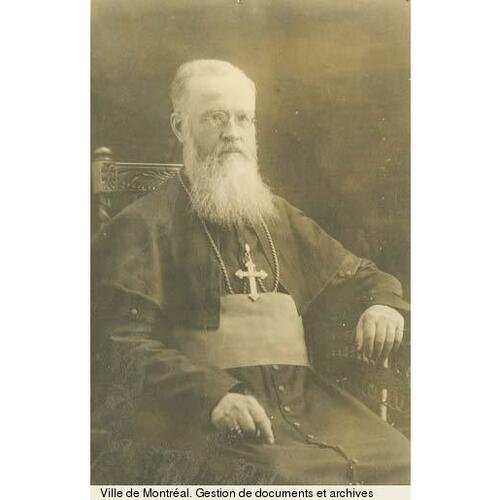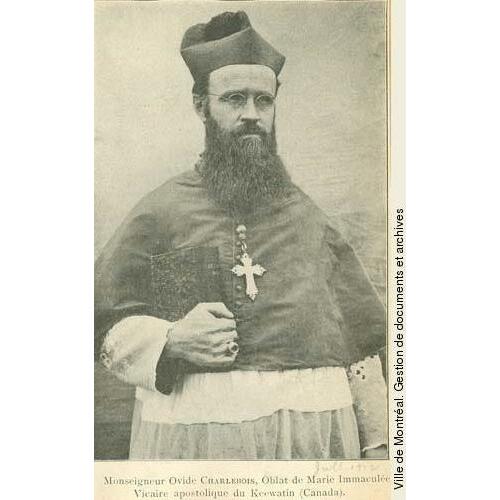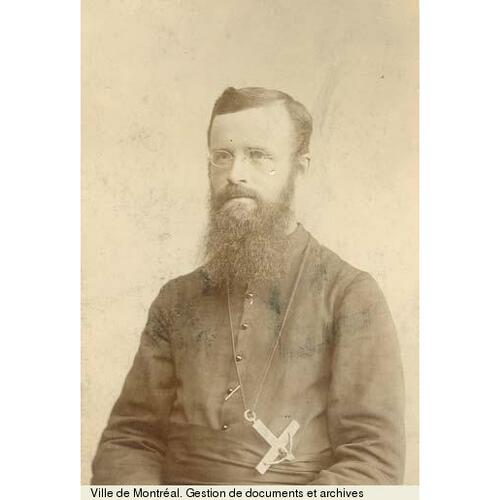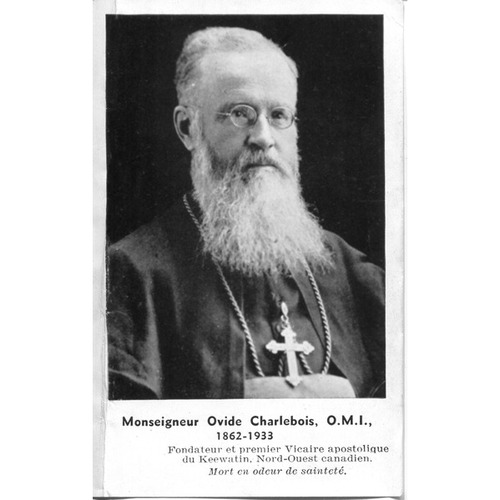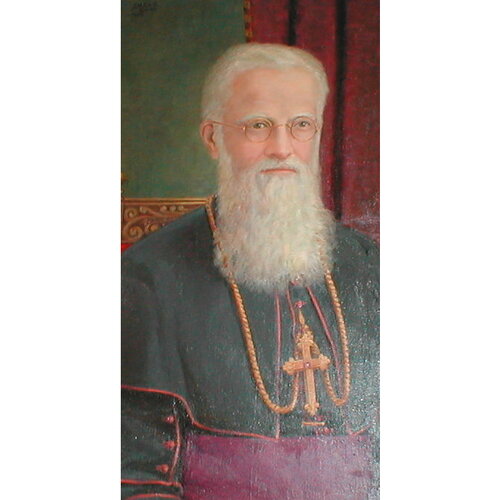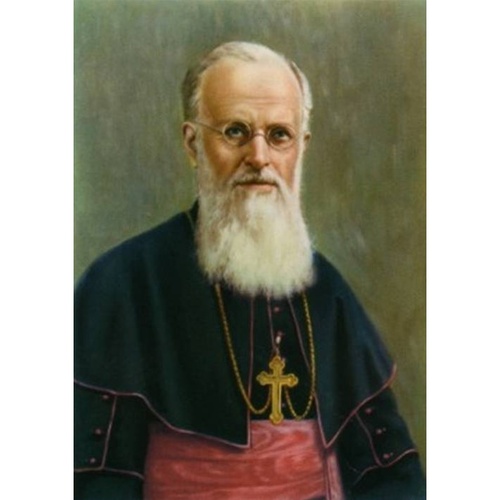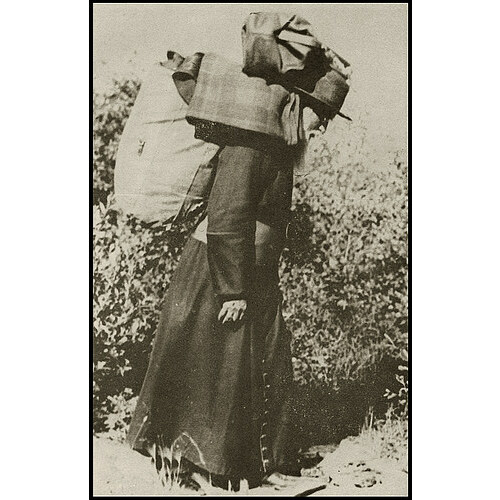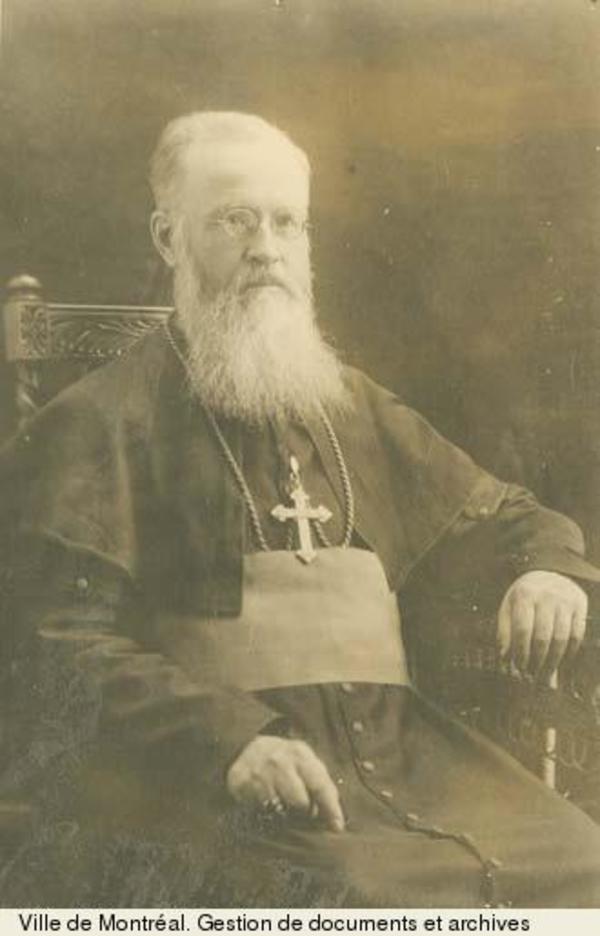
Source: Link
Charlebois, Ovide (baptized William-Ovide), Oblate of Mary Immaculate and Roman Catholic priest, teacher, school administrator, and bishop; b. 17 Feb. 1862 in Lac-des-Deux-Montagnes (Oka), Lower Canada, son of Hyacinthe Charlebois and Émérente (Émérence) Chartier (Chartier-Robert); d. 20 Nov. 1933 in The Pas, Man.
Soon after his birth Ovide Charlebois, the seventh of 14 children, moved with his family to nearby Saint-Benoît (Mirabel), and in 1864 they settled in Sainte-Marguerite-du-Lac-Masson, northwest of Terrebonne. Ovide obtained rudimentary instruction at the local school. From 1876 to 1882 he attended the Collège de L’Assomption and then he entered the Oblate noviciate in Lachine (Montreal). After he made his initial vows in 1883 he studied theology and philosophy at the College of Ottawa and the Saint-Joseph scholasticate. He took his perpetual vows in 1884, received the tonsure two years later, and was ordained priest in Ottawa by Bishop Vital-Justin Grandin* of the diocese of St Albert on 17 July 1887.
In September Charlebois began his long missionary career at Cumberland House (Sask.). While at the noviciate, he had expressed a willingness to serve in the Canadian northwest, but had also indicated a fear of being alone. Ironically, during his first four years in the immense Cumberland district, the longest time he spent with a fellow Oblate was one and a half months. In 1890 he established a school at Cumberland House, and besides seeing to his regular missionary duties he taught there four hours each day. Yet he was obliged to travel extensively to minister to the dispersed indigenous and Métis population. He estimated that during the winter of 1900–1 he journeyed some 3,000 miles by snowshoe and dogsled and camped 35 times in the snow.
In 1903 Charlebois was named principal of St Michael’s Indian Residential School at Duck Lake. In addition to teaching catechism in Cree to the students and caring for those who were ill, he also strove to reduce the school’s debt of over $10,000 and ameliorate its physical plant. Like others of his era, he believed that the well-being of indigenous students could be improved by removing them from the influence of their communities. Conditions at St Michael’s, however, like those in many residential schools at the time [see Peter Henderson Bryce], were unsafe and unsanitary, which led to disease and an alarming death rate (by the end of 1910 nearly half of the school’s students from a nearby reserve had died). In a proposal to the federal government in 1909 he suggested that it establish a special agricultural colony to help discharged pupils become self-sufficient farmers. He also recommended that senior scholars be allowed to work in order to gain practical experience: the boys could learn to operate a farm and the girls to manage a home. As an experiment, the Department of Indian Affairs (DIA) authorized Charlebois to place several discharged female students in non-indigenous homes as domestic servants, despite protests from their parents. It was only after a DIA agent wrote a letter to his department calling the situation “akin to slavery” that the project was abandoned.
While at Duck Lake, Charlebois collaborated in launching a Roman Catholic, French-language newspaper to serve the needs of the province’s isolated minority. In December 1908 he and Abbé Pierre-Elzéar Myre of neighbouring Bellevue (St-Isidore-de-Bellevue) outlined the role and policy of the paper and, along with other clergy, they purchased shares in the Société de la Bonne Presse Limitée, the company they set up to publish Le Patriote de l’Ouest. Printed in a woodworking shop at the boarding school, the paper first appeared in August 1910, edited by Father Adrien-Gabriel Morice. In November fire destroyed the printing equipment, but the paper started up again in June 1911. Charlebois also contributed to enhancing the status of a grotto at Saint-Laurent-de-Grandin (St-Laurent-Grandin) by making the pilgrimage to the site an annual event for the students; local residents also adopted the practice.
In 1907 the formation of a new vicariate apostolic, consisting of the northern parts of Saskatchewan, Manitoba, and Ontario, was discussed as a means of facilitating missionary work. Archbishop Adélard Langevin* of St Boniface in Manitoba had already put forward Charlebois’s candidacy as its head to the Oblate general administration. On 4 March 1910 Rome created the vicariate apostolic of Keewatin and on 8 August named Charlebois titular bishop of Berenice and vicar apostolic. On 30 November he was consecrated bishop in L’Assomption, Que., by Langevin. Unfortunately, the Oblate administration refused to accept responsibility for the new vicariate because it could not provide sufficient clergy to ensure proper functioning. The administration claimed that it had not been consulted on the erection of the vicariate or on the nomination of a bishop. Hence, Charlebois was forced to spend considerable time, expense, and effort recruiting personnel and raising money for his apostolic work.
Charlebois established his episcopal residence at The Pas in a log cabin, 14 feet by 14 feet. In May 1911 he began a five-month tour of his vicariate, travelling some 2,500 miles by foot, canoe, wagon, and railway to visit 14 missions and posts. In 1915 he divided the vast region into three districts, each under the direction of a superior, and every year afterwards he visited one of the districts in turn. His arrival at a mission was a source of jubilation and celebration, marked by the discharge of firearms. Those who greeted him then knelt to receive his benediction and a handshake, ceremonies that were followed by religious instruction, sermons, and the sacraments. These pastoral visits were a source of great consolation for the Oblate missionaries as well, many of whom were without colleagues and, hence, unable to follow the rule of their order with respect to communal living.
Education remained a major concern for Charlebois and he became involved in school controversies in Manitoba, Ontario, and Saskatchewan. When Manitoba Premier Rodmond Palen Roblin succeeded in having the boundaries of his province extended northward into the District of Keewatin in 1912, Charlebois unsuccessfully petitioned the federal government of Robert Laird Borden to maintain the constitutional right of Catholics in the area to state-supported separate schools. He encouraged the Association Canadienne-Française d’Éducation d’Ontario in its conflict with the provincial administration of Sir James Pliny Whitney* over Regulation 17 [see Ovide-Arthur Rocque*]. Saskatchewan public schools in his vicariate would be subject to legislation prohibiting the display of religious garb and emblems enacted in 1930 by Premier James Thomas Milton Anderson*. Although not outspoken like his metropolitan, Langevin, Charlebois tirelessly promoted the rights of French Catholics in a number of matters, including the question of episcopal nominations in Ontario and western Canada, the creation of new dioceses, the establishment of the Association Catholique Franco-Canadienne de la Saskatchewan in 1912, the protests against the contents of high-school textbooks in Manitoba, and the petitions to reinstate the original name of Le Pas, which had been incorporated that year as The Pas.
Given its northern location, the Keewatin vicariate was ideally situated to promote the evangelization of the Canadian Arctic’s Inuit. In 1911 Charlebois asked Oblate Arsène Turquetil* to explore the region and evaluate its potential for the foundation of missions. In September of the following year Turquetil began constructing a mission at the hamlet of Chesterfield Inlet (Nunavut), which would become the largest Catholic mission in the eastern Arctic. Charlebois authorized a mission at Eskimo Point (Arviat) in 1925 and planned to set up others, but they never materialized because responsibility for the eastern Arctic was detached from his jurisdiction in 1925 and transferred to the newly created prefecture apostolic of Hudson Bay. This decision profoundly distressed him because he had not been consulted.
The discovery and exploitation of minerals and other natural resources in the region during the mid 1920s transformed the nature of Charlebois’s vicariate. The establishment of mines, smelters, hydroelectric projects, and the Hudson Bay Railway brought in a large white population, and new missions had to be built. Although the indigenous population increased only slightly during Charlebois’s ministry, from about 10,000 persons to 11,150 in 1933, the non-indigenous population jumped from about 100 residents to 11,500. The influx created serious social problems and the bishop denounced the nefarious influence of the newcomers on indigenous peoples, urging his clergy to combat “these powerful sources of perversion and demoralization.”
As a result of Charlebois’s endeavours, his vicariate, which had 9 missions in 1911, contained 19 in 1933 and the number of clergy and religious had increased threefold. Despite his advancing age, he continued to undertake gruelling pastoral visits. In 1923, for example, he had travelled 1,000 miles by canoe, walked some 80 miles of portages, and slept 23 nights in the open. He had travelled to seven missions, preached retreats that lasted from five to seven days to some 2,500 members of First Nations, and administered confirmation to 220 persons. In 1927, while returning from a one-month visit to missions in Norway House and Cross Lake, Man., his boat nearly capsized twice in Lake Winnipeg. He admitted that he was exhausted. During the period from 1911 to 1922 he had journeyed five times to Île-à-la-Crosse, Sask., to preach weeklong retreats or provide religious instruction.
Charlebois always demonstrated great concern for the education of indigenous people and sought to offer them more than what was provided by the rudimentary mission schools. Consequently, he began to petition the federal government for the establishment of residential schools and, after considerable effort, he succeeded in obtaining two new ones: at Cross Lake in Manitoba and at Sturgeon Landing in Saskatchewan. He had great hopes for these institutions as well as for the one at Beauval, which had been founded in 1895 and was to serve as a scholasticate. On 19 Sept. 1927, however, that building burned to the ground; 1 nun and 19 students perished. The financial loss was evaluated at $50,000. Charlebois began the reconstruction at his own expense while awaiting government assistance. In 1930 students set fire to the school at Cross Lake; a nun and 11 students lost their lives.
In his last years Charlebois became obsessed with communism, which he condemned in no uncertain terms. While attending the general meeting of Canadian bishops in Quebec City in 1933, he became ill. On his return to The Pas, he was admitted to hospital, and he died there, aged 71.
Fluent in Cree and Chipewyan, Charlebois was a skilful carpenter, constructing chapels, schools, and residences as well as his episcopal residence and cathedral in The Pas. He was, and remained, a very humble person. In 1905, in keeping with the precepts of poverty and self-denial, he had refrained from visiting his dying father and attending the funeral. For his own service he insisted on a pauper’s burial; his coffin cost $40. His cause for beatification was begun in 1951 and submitted to Rome in 1953.
Ovide Charlebois oversaw a vast, isolated vicariate with a harsh climate; these factors complicated travel and the establishment of missions, and subjected him and his missionaries to incredible hardship. Devoid of worldly pretensions, he admired the virtues of poverty, humility, and mortification. He considered it his duty to expand God’s kingdom and he did so without seeking recognition or praise. His life’s work, however, contains some regrettable episodes, as demonstrated in particular by the conditions that reigned at St Michael’s residential school during his principalship.
Ovide Charlebois is the author of “Vicariat du Keewatin: Mgr Charlebois, o.m.i., en tournée pastorale,” Missions de la Congrégation des missionnaires oblats de Marie Immaculée (Rome), 53 (1919): 277–92; Mgr O. Charlebois, o.m.i., v.a., chez les Esquimaux: notes de voyage, visite pastorale, ordination, etc. (Ottawa, [1923]); and, with Arsène Turquetil, of Débuts d’un évêque missionnaire: Mgr Ovide Charlebois, o.m.i., évêque de Bérénice, vicaire apostolique du Keewatin: prise de possession, installation, première visite pastorale des missions sauvages (Montréal, n.d.).
Arch. Deschâtelets, Oblats de Marie-Immaculée (Ottawa), H 5201-5250; LC 6001-8000. Le Patriote de l’Ouest (Prince Albert, Sask.), 21 févr. 1923. Gaston Carrière, Dictionnaire biographique des oblats de Marie-Immaculée au Canada (4v., Ottawa, 1976–89); Le père du Keewatin: Mgr Ovide Charlebois, o.m.i., 1862–1933 (Montréal, 1962). A. R. Greyeyes, “St. Michael’s Indian Residential School 1894–1926: a study within a broader historical and ideological framework” (msw thesis, Carleton Univ., Ottawa, 1995). R. [J. A.] Huel, “The Anderson amendments and the secularization of Saskatchewan public schools,” CCHA, Study sessions, 44 (1977): 61–76. Martin Lajeunesse, Directives missionnaires (The Pas, Man., 1942). “O. Charlebois à mon très révérend père général, 10 novembre 1901,” Missions de la Congrégation des missionnaires oblats de Marie Immaculée (Paris), 40 (1902): 48. J.‑M. Pénard, The vicar apostolic of Keewatin, Canada, Bishop Ovide Charlebois, trans. M. A. Gray (Montreal, 1939). Marius Rossignol, “Mission de l’Île-à-la-Crosse,” Missions de la Congrégation des missionnaires oblats de Marie Immaculée (Rome), 56 (1922): 49–59. Arsène Turquetil, “Chez les Esquimaux du Keewatin,” Missions de la Congrégation des missionnaires oblats de Marie Immaculée (Rome), 50 (1912): 441–44. “Un journal catholique et français en Saskatchewan,” Les Cloches de Saint-Boniface (Saint-Boniface [Winnipeg]), 9 (1910): 70. “Vicariat du Keewatin: rapport du révérendissime vicaire des missions,” Missions de la Congrégation des missionnaires oblats de Marie Immaculée, 56: 47.
Cite This Article
Raymond Huel, “CHARLEBOIS, OVIDE (baptized William-Ovide),” in Dictionary of Canadian Biography, vol. 16, University of Toronto/Université Laval, 2003–, accessed January 18, 2026, https://www.biographi.ca/en/bio/charlebois_ovide_16E.html.
The citation above shows the format for footnotes and endnotes according to the Chicago manual of style (16th edition). Information to be used in other citation formats:
| Permalink: | https://www.biographi.ca/en/bio/charlebois_ovide_16E.html |
| Author of Article: | Raymond Huel |
| Title of Article: | CHARLEBOIS, OVIDE (baptized William-Ovide) |
| Publication Name: | Dictionary of Canadian Biography, vol. 16 |
| Publisher: | University of Toronto/Université Laval |
| Year of publication: | 2018 |
| Year of revision: | 2018 |
| Access Date: | January 18, 2026 |


